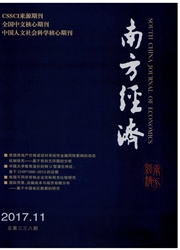

 中文摘要:
中文摘要:
改革开放以来,中国的制造业空间格局发生了显著的重构。本文基于中国省区尺度的制造业数据,描述了改革开放以来到2008年期间的中国制造业的空间集聚的变化趋势和特征。总体上,现阶段中国的制造业地理集聚程度较高,主要集聚在东部沿海地区。然而中国制造业地理集聚存在显著的产业差异,依赖于特定自然资源投入的产业,地理集聚程度相对较低,而依赖大量中间产品投入的资本技术密集型产业的地理集聚度则较高。劳动密集型产业由于是外资主导并且以出口为主,高度集中在沿海省区。中国的产业集聚变化趋势具有明显的阶段性特征,从上个世纪90年代初开始,产业地理集聚程度上升进入了加速期,地理集聚程度在2004年左右达到顶峰。本文回顾了中国产业地理集聚的理论和实证研究,传统的贸易理论、新经济地理学理论和集聚经济理论是理解中国的产集聚的重要视角,但中国转型经济的特殊制度环境下,市场化、全球化和地方分权对中国制造业集聚和分散具有显著影响。随着中国经济转型的深化及其在全球经济体中地位的调整,全球力量与地方力量的相互作用将不断重塑中国的制造业地理格局。
 英文摘要:
英文摘要:
The spatial pattern of manufacturing sectors in China has been significantly reshaped since the late 1970s. Drawing on data of manufacturing sectors at provincial level, this study analyzes the geographical agglomeration of manufacturing industries in China during the period from 1980 to 2008. Generally, manufacturing industries are highly agglomerated in the coastal areas in China. However, there exist significant differences among varied industries. The industries that need a large amount of natural resources are more dispersed, while those capital intensive industries which need a lot of intermediate inputs are more agglomerated. The trend of becoming more agglomerated of manufacturing sectors started to speed up from the early 1990s and reached to the peak around 2004. According to the literature review, the theories of international trade, the new economic geography and agglomeration economy can explain the agglomeration of manufacturing industries in China. However, as a typical transitional economy, the processes of marketilization, globalization and regional discentralization have played very important roles in reshaping the spatial distribution of manufacturing sectors in China. The global and local forces will continue to influence the spatial pattern of manufacturing industries with the deepening of the reforms and China becoming more integrated to world economy.
 同期刊论文项目
同期刊论文项目
 同项目期刊论文
同项目期刊论文
 Regional and Sectoral Differences in the Spatial Restructuring of Chinese Manufacturing Industries i
Regional and Sectoral Differences in the Spatial Restructuring of Chinese Manufacturing Industries i Spatial Organization of Fortune Global 500 Corporations in China: An Empirical Study of Multinationa
Spatial Organization of Fortune Global 500 Corporations in China: An Empirical Study of Multinationa Geographical Dynamics and Industrial Relocation: Spatial Strategies of Apparel Firms in Ningbo, Chin
Geographical Dynamics and Industrial Relocation: Spatial Strategies of Apparel Firms in Ningbo, Chin 期刊信息
期刊信息
